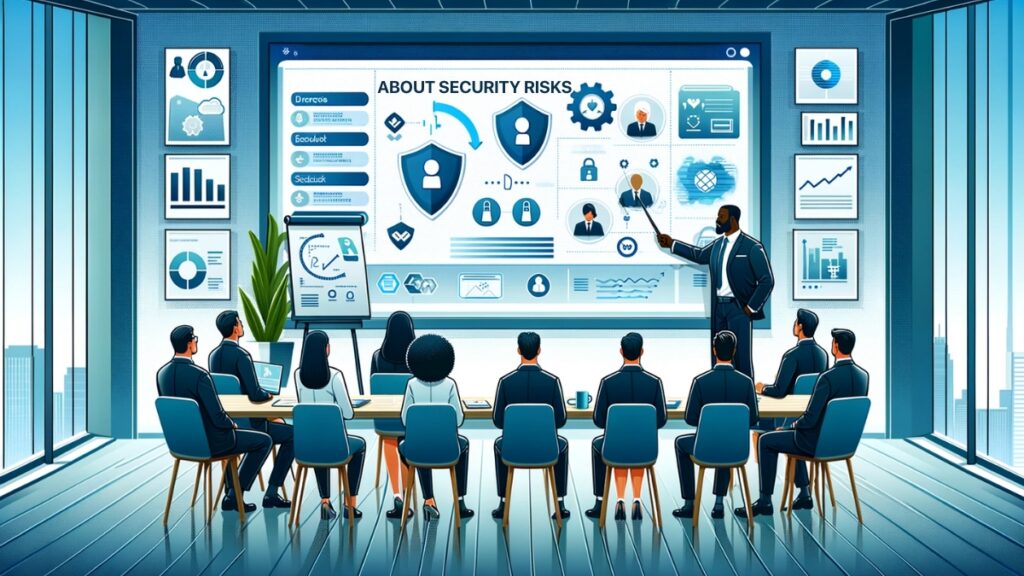In today’s interconnected world, network security is a paramount concern for individuals and organizations alike. As we rely more on digital systems and the internet for communication, data storage, and business operations, the risks associated with cyber threats continue to grow. To navigate this evolving landscape, it’s crucial to implement network security best practices that safeguard your data and infrastructure.
The Importance of Network Security
Network security encompasses the measures and strategies put in place to protect a computer network from unauthorized access, breaches, and other cyber threats. It is not limited to large corporations or government entities; even individuals and small businesses should be vigilant about network security. Here’s why:
- Data Protection: Your network likely contains sensitive information, whether it’s personal data, financial records, or intellectual property. Failure to secure this data can lead to data breaches, identity theft, and significant financial losses.
- Business Continuity: For businesses, network downtime due to security breaches can be catastrophic. It can result in loss of revenue, damage to reputation, and even legal liabilities. Network security ensures the continuity of operations.
- Privacy Concerns: Protecting the privacy of individuals and customers is a legal and ethical responsibility. Failure to maintain privacy can result in legal penalties and damage to your brand’s reputation.
- Compliance Requirements: Many industries and regions have specific regulations regarding data security. Non-compliance can lead to fines and legal consequences.
The Evolving Landscape of Cyber Threats
Cyber threats are constantly evolving, becoming more sophisticated and diverse with each passing day. Attackers employ a range of techniques to exploit vulnerabilities in networks. Some common cyber threats include:
- Malware: This includes viruses, Trojans, ransomware, and spyware that can infect your network, steal data, or disrupt operations.
- Phishing: Cybercriminals use deceptive emails and websites to trick users into revealing sensitive information like passwords and credit card numbers.
- Distributed Denial of Service (DDoS) Attacks: These attacks overwhelm a network or website with traffic, causing it to become inaccessible.
- Insider Threats: Employees or trusted individuals with access to your network may misuse their privileges, intentionally or unintentionally causing harm.
- Zero-Day Vulnerabilities: Attackers exploit newly discovered vulnerabilities before they are patched by software vendors.
To effectively protect your network, it’s essential to stay informed about emerging threats and constantly update your security measures. This article will guide you through the best practices to secure your network against these evolving threats.
Assessing Your Network Vulnerabilities
To build a robust network security infrastructure, it’s essential to begin by assessing your network’s vulnerabilities. This process involves identifying potential weak points and security gaps that could be exploited by cyber threats. Here, we will outline the steps to conduct a comprehensive network security audit and help you understand why it’s a critical first step in safeguarding your network.
Conducting a Comprehensive Network Security Audit
A network security audit is a systematic evaluation of your network infrastructure, policies, and procedures to determine its security posture. This audit serves as the foundation for developing a strong security strategy. Here are the key steps involved:
Inventory and Documentation
Begin by creating a detailed inventory of all network assets, including hardware devices (servers, routers, switches, etc.) and software applications. Document their configurations and network connections. This documentation will be valuable for tracking changes and identifying vulnerabilities.
Vulnerability Scanning
Use specialized vulnerability scanning tools to identify known weaknesses and vulnerabilities in your network. These tools can automatically scan your network for common security issues, such as outdated software, misconfigured settings, or unpatched systems.
Penetration Testing
Consider conducting penetration tests (pen tests) to simulate real-world cyberattacks. Ethical hackers, known as penetration testers, attempt to exploit vulnerabilities in your network to assess its resilience. Penetration testing helps uncover vulnerabilities that may not be apparent through automated scans.
Access Control Review
Evaluate user access controls and permissions to ensure that only authorized personnel have access to sensitive data and network resources. Revise and tighten access control policies as needed.
Security Policy Review
Review your organization’s security policies and procedures. Ensure they align with best practices and industry standards. Update policies to address emerging threats and technology changes.
Threat Modeling
Identify potential threats and risks specific to your organization. Consider factors like the value of your data, potential attackers, and the impact of a security breach. This understanding will help you prioritize security measures effectively.
Why a Network Security Audit Matters
Conducting a network security audit is not a one-time task; it should be an ongoing process. Here’s why it matters:
- Identification of Vulnerabilities: A thorough audit helps you discover vulnerabilities before attackers do, allowing you to patch or mitigate them proactively.
- Risk Mitigation: By identifying and addressing vulnerabilities, you reduce the risk of security breaches and their associated costs.
- Compliance: Many industries and regulations require regular security assessments and audits to ensure compliance.
- Continuous Improvement: Regular audits help you continually improve your network security posture as technology and threats evolve.
- Data Protection: An audit helps protect sensitive data and ensures it is handled according to best practices.
Strong Password Policies
Effective password management is a fundamental aspect of network security. Weak or easily guessable passwords can serve as an open invitation to cybercriminals looking to gain unauthorized access to your network and sensitive data. In this section, we will explore the role of passwords in network security and provide guidelines for creating and managing secure passwords.
The Role of Passwords in Network Security

Passwords act as the first line of defense against unauthorized access to your network and accounts. They serve as a barrier that should be difficult for attackers to breach. However, the effectiveness of passwords depends on their complexity and how well they are managed. Here’s why passwords matter:
- Authentication
- Passwords are used to verify the identity of users and grant access to authorized personnel. Strong passwords are a critical component of the authentication process.
- Data Protection
- Secure passwords help protect sensitive data stored on network servers, preventing unauthorized individuals from accessing or stealing valuable information.
- Account Security
- User accounts with weak passwords are vulnerable to compromise, potentially leading to unauthorized access, data breaches, and even financial losses.
Guidelines for Creating Secure Passwords
Creating strong and complex passwords is essential to enhance your network security. Consider the following guidelines when crafting passwords:
- Length
- Make your passwords long. Longer passwords are generally more secure. Aim for a minimum of 12 characters.
- Complexity
- Use a combination of uppercase and lowercase letters, numbers, and special characters (e.g., !, @, #, $, %). Avoid using easily guessable patterns like “123456” or “password.”
- Unpredictability
- Avoid using common words or phrases, such as “password” or “admin,” and refrain from using easily discoverable personal information like birthdays or names of family members.
- Avoid Dictionary Words
- Don’t use complete words found in dictionaries, as attackers often use dictionary attacks to crack passwords.
- Passphrases
- Consider using passphrases – a series of random words or a sentence that is easy to remember but difficult to guess. For example, “PurpleTiger$Dances@Midnight.”
- Unique Passwords
- Use unique passwords for each account or service. Reusing passwords across multiple accounts increases your vulnerability in case one password is compromised.
- Password Managers
- Consider using a reputable password manager tool to generate and store complex passwords securely. Password managers can also help you keep track of your passwords for various accounts.
- Regular Updates
- Change passwords periodically, especially for critical accounts. Regularly updating passwords reduces the risk of a compromised account.
Password Policy Implementation
Implementing strong password policies within your organization is essential. These policies should specify the requirements for password creation, expiration, and usage. Here are some key elements of a robust password policy:
- Password Complexity Requirements: Define the minimum length and complexity (use of uppercase, lowercase, numbers, and special characters) for passwords.
- Password Expiration: Specify how often users should change their passwords to minimize the risk of long-term compromises.
- Account Lockout: Implement account lockout policies that temporarily disable accounts after a certain number of failed login attempts to prevent brute-force attacks.
- Two-Factor Authentication (2FA): Encourage or require the use of 2FA for added security.
By establishing and enforcing these password policies, you can significantly enhance your network security by minimizing the chances of unauthorized access.
Implementing Multi-Factor Authentication (MFA)
In the ever-evolving landscape of cybersecurity threats, multi-factor authentication (MFA) has emerged as a powerful safeguard against unauthorized access. This section will delve into what MFA is, why it’s crucial for network security, and how you can implement it to fortify your defenses.
What is Multi-Factor Authentication (MFA)?
Multi-Factor Authentication (MFA), also known as two-factor authentication (2FA) or two-step verification, is a security process that requires users to provide two or more separate forms of identification before gaining access to an account or network. These factors typically fall into three categories:
- Something You Know: This is typically a password or PIN, something the user knows.
- Something You Have: This can be a physical device like a smartphone, security token, or smart card.
- Something You Are: This involves biometric data such as fingerprints, retina scans, or facial recognition.
The Importance of MFA in Network Security
MFA serves as an additional layer of security beyond traditional password authentication. Here’s why it is crucial for network security:
Mitigating Password Vulnerabilities
Passwords alone are susceptible to various threats, including phishing attacks, brute-force attempts, and stolen credentials. MFA adds an extra barrier, making it significantly harder for attackers to compromise accounts, even if they obtain passwords.
Enhanced Account Security
With MFA in place, even if an attacker gains access to a user’s password, they would still need the second authentication factor (e.g., a smartphone or fingerprint) to complete the login. This provides an additional layer of defense against unauthorized access.
Reducing the Impact of Data Breaches
In the event of a data breach where user credentials are exposed, MFA can prevent immediate unauthorized access, as attackers would lack the second factor required for authentication.
Steps to Implement Multi-Factor Authentication
Implementing MFA within your network can significantly bolster your security posture. Here are the key steps to get started:
- Identify Critical Accounts
- Begin by identifying the accounts and services that contain sensitive data or have a high potential for impact in case of a security breach. Examples include email accounts, admin consoles, and financial systems.
- Choose MFA Methods
- Select the MFA methods that align with your organization’s needs and user preferences. Common methods include text messages, mobile apps (like Google Authenticator or Authy), hardware tokens, and biometric authentication.
- Enable MFA for Accounts
- For each identified account, enable and configure MFA settings. Many online services and applications offer built-in MFA options. Alternatively, you can use third-party MFA solutions.
- Communicate and Educate
- Inform your users about the implementation of MFA and provide clear instructions on how to set it up. Offer support and training to ensure a smooth transition.
- Test and Monitor
- Thoroughly test the MFA setup to ensure it works as intended. Continuously monitor its effectiveness and make adjustments as needed.
- Consider Adaptive Authentication
- Adaptive authentication systems analyze user behavior and context to determine whether MFA is required. This approach adds an extra layer of security by only prompting for additional authentication when suspicious activity is detected.
Firewall and Intrusion Detection Systems (IDS)
Firewalls and Intrusion Detection Systems (IDS) are essential components of network security, serving as the first line of defense against external threats. In this section, we will delve into the significance of firewalls and IDS in network defense and provide guidance on how to configure and maintain these critical security measures.
The Significance of Firewalls and IDS in Network Defense

Firewalls
A firewall is a network security device or software that monitors and filters incoming and outgoing network traffic based on predefined security rules. Its primary goal is to establish a barrier between your internal network and potentially harmful external networks, such as the internet. Here’s why firewalls are crucial:
- Access Control: Firewalls allow you to control which network traffic is permitted or denied, reducing the attack surface.
- Traffic Inspection: They inspect packets of data, filtering out malicious or unauthorized content before it reaches your network.
- Protection from Threats: Firewalls protect against common threats like malware, ransomware, and unauthorized access attempts.
Intrusion Detection Systems (IDS)
An Intrusion Detection System (IDS) is a security tool that monitors network or system activities for suspicious or malicious behavior. IDS operates by analyzing network traffic patterns and identifying anomalies that may indicate an intrusion or security breach. Here’s why IDS is critical:
- Anomaly Detection: IDS can identify deviations from established baselines, flagging potentially malicious activities.
- Early Warning: It provides early warnings of security incidents, allowing for rapid response and mitigation.
- Log Generation: IDS generates logs that can be valuable for incident investigation and forensics.
How to Configure and Maintain Firewalls and IDS
Configure Firewalls
When configuring firewalls, consider the following best practices:
- Default Deny: Set a default rule to deny all traffic and only allow specific traffic that is necessary for your network’s functionality.
- Rule Organization: Organize firewall rules logically, with more specific rules taking precedence over general rules.
- Regular Rule Review: Regularly review and update firewall rules to adapt to changing network requirements and emerging threats.
- Logging: Enable firewall logging to monitor and analyze traffic. Log data can provide insights into potential security incidents.
Intrusion Detection Systems (IDS)
When configuring and maintaining IDS:
- Signature Updates: Ensure IDS signatures are up to date to detect the latest threats.
- Alert Thresholds: Adjust alert thresholds to reduce false positives while ensuring genuine threats are detected.
- Log Analysis: Regularly analyze IDS logs to identify potential security incidents and patterns of suspicious behavior.
- Response Plan: Develop an incident response plan that includes procedures for handling alerts generated by the IDS.
Regular Software Patching and Updates
Regular software patching and updates are critical elements of network security. Keeping your software, operating systems, and applications up-to-date helps close security vulnerabilities and protect your network from exploitation by cybercriminals. In this section, we will explore the importance of software updates and strategies for automating and managing patching processes.
The Importance of Regular Software Patching and Updates
Vulnerability Mitigation
Software developers continually discover and address security vulnerabilities in their products. These vulnerabilities can be exploited by attackers to gain unauthorized access or compromise your network. Regular updates typically include patches to fix these vulnerabilities.
Improved Performance and Stability
Software updates often include performance enhancements and bug fixes, leading to a more stable and efficient network environment. Outdated software can be prone to crashes and errors, potentially affecting productivity.
Compliance Requirements
In many industries, compliance regulations mandate regular software updates as part of the security measures required to protect sensitive data and maintain regulatory compliance. Neglecting updates can result in legal and financial consequences.
Enhanced Features
In addition to security and performance improvements, software updates may introduce new features and capabilities that can benefit your organization. Staying up-to-date ensures you can take advantage of these advancements.
Strategies for Automating and Managing Software Updates
Create an Inventory
Maintain an inventory of all software, operating systems, and applications used within your network. This inventory will help you track what needs to be updated.
Prioritize Updates
Not all updates are equally critical. Prioritize updates based on the severity of vulnerabilities, the importance of the software to your operations, and any regulatory requirements.
Implement Patch Management Tools
Use patch management tools to automate the process of identifying and applying updates. These tools can help streamline the update process and ensure consistency.
Schedule Downtime
Plan software updates during scheduled maintenance windows or downtime to minimize disruptions to your network and users.
Test Updates
Before applying updates to production systems, test them in a controlled environment to ensure they do not introduce new issues or conflicts.
Monitor and Verify
Regularly monitor the status of updates and verify that they have been successfully applied. Automated monitoring tools can help with this task.
Employee Training and Awareness
One of the often underestimated yet critical aspects of network security is employee training and awareness. No matter how robust your technical defenses may be, the actions of individuals within your organization can significantly impact your network’s security. In this section, we will emphasize the importance of educating your staff about security risks and best practices.
Educating Staff about Security Risks

Phishing Attacks
Phishing attacks remain one of the most common ways for cybercriminals to gain access to networks. Train employees to recognize phishing emails, suspicious links, and requests for sensitive information.
Social Engineering
Attackers may attempt to manipulate employees into divulging confidential information or performing actions that compromise security. Teach your staff to be cautious about sharing information with unverified sources.
Password Security
As discussed in Section 3, strong password practices are essential. Employees should understand the importance of creating strong, unique passwords and safeguarding them from unauthorized access.
Malware Awareness
Educate your staff about the risks associated with downloading attachments or clicking on links from unknown sources. Malware can infect your network and compromise sensitive data.
Providing Ongoing Training
Simulated Phishing Exercises
Conduct regular simulated phishing exercises within your organization to test employees’ ability to identify phishing attempts. Use these exercises as educational opportunities, providing feedback and guidance.
Security Workshops and Seminars
Host workshops and seminars on network security best practices. Cover topics such as safe internet browsing, email security, and recognizing social engineering attempts.
Incident Response Training
Ensure employees know what to do in case of a security incident. Establish clear procedures for reporting incidents, and provide training on how to respond effectively to minimize damage.
Fostering a Culture of Security
Leadership Support
Leaders within the organization should champion a culture of security. When leadership emphasizes the importance of security, employees are more likely to prioritize it.
Security Policies
Establish clear and comprehensive security policies and guidelines, and ensure that employees are aware of and understand these policies. Regularly update policies to reflect evolving threats.
Rewards and Recognition
Acknowledge and reward employees who actively contribute to the security of the organization. This can encourage a sense of ownership and responsibility for network security.
Data Encryption and Secure Protocols
Data encryption and the use of secure communication protocols are fundamental components of network security. They ensure that data transmitted over your network remains confidential and protected from eavesdropping and interception. In this section, we will delve into the significance of data encryption and secure communication protocols, as well as how to implement them effectively.
The Importance of Data Encryption
Confidentiality
Encryption transforms data into a scrambled format that can only be decrypted by authorized parties with the appropriate encryption keys. This ensures the confidentiality of sensitive information, even if it falls into the wrong hands.
Data Integrity
Encryption also helps maintain data integrity. It ensures that data remains unchanged during transmission, protecting it from tampering or unauthorized modification.
Regulatory Compliance
Many industries and regulations require the encryption of sensitive data to meet compliance standards. Failure to do so can result in legal consequences.
Implementing Data Encryption
Encryption Algorithms
Choose strong encryption algorithms and protocols for securing data both in transit and at rest. Common encryption algorithms include AES (Advanced Encryption Standard) for data and TLS (Transport Layer Security) for communication.
Secure Socket Layer (SSL) / Transport Layer Security (TLS)
Implement SSL/TLS protocols to secure data transmitted over networks, particularly for web-based communication. Ensure that SSL/TLS certificates are up-to-date and properly configured.
End-to-End Encryption
Consider implementing end-to-end encryption for sensitive communications. This ensures that data is encrypted on the sender’s side and can only be decrypted by the intended recipient.
The Role of Secure Communication Protocols

HTTPS (Hypertext Transfer Protocol Secure)
Use HTTPS for web communication. It encrypts data between the user’s web browser and the web server, protecting sensitive information such as login credentials and financial data during online transactions.
VPN (Virtual Private Network)
Implement VPNs to create secure, encrypted connections between remote users and your network. VPNs are particularly important for securing remote work and protecting data in transit.
Secure Email Protocols
Use secure email protocols like S/MIME (Secure/Multipurpose Internet Mail Extensions) and PGP (Pretty Good Privacy) to encrypt email messages and attachments.
Network Access Control (NAC)
Network Access Control (NAC) is a crucial element of network security that focuses on controlling and managing access to your network resources. It helps ensure that only authorized devices and users gain entry while preventing unauthorized access and potential security threats. In this section, we will explore the significance of NAC and the steps to enforce access control effectively.
The Importance of Network Access Control (NAC)
Access Management
NAC enables organizations to manage access permissions effectively, ensuring that only authorized users and devices can connect to the network.
Threat Mitigation
By monitoring and controlling device access, NAC helps mitigate the risks associated with unauthorized or compromised devices entering the network.
Compliance Enforcement
NAC solutions can enforce compliance with security policies, ensuring that devices meet specific security requirements before gaining network access.
Enforcing Network Access Control
Authentication and Authorization
Implement strong authentication mechanisms to verify the identity of users and devices seeking network access. Use methods like username/password authentication or certificates for devices.
Device Profiling
Utilize device profiling to automatically identify and classify devices as they connect to the network. This helps in enforcing security policies tailored to different device types.
Role-Based Access Control (RBAC)
Implement RBAC to assign different levels of access and permissions to users and devices based on their roles and responsibilities within the organization.
Posture Assessment
Conduct posture assessments to evaluate the security posture of devices before granting network access. This ensures that devices meet security standards.
Guest Network Access
Create isolated guest networks with restricted access to sensitive resources, ensuring that guests do not pose a security risk to the main network.
Continuous Monitoring
Implement continuous monitoring to track device behavior and detect any anomalies or suspicious activities within the network.
Incident Response Plan
An incident response plan is a critical component of network security. Despite the best preventive measures, security incidents can still occur. Having a well-defined incident response plan in place is essential to minimize the impact of a security breach, ensure a swift response, and protect your network and data. In this section, we will delve into the importance of having an incident response plan and the steps to follow when a security incident occurs.
The Importance of an Incident Response Plan
Rapid Response
An incident response plan outlines specific steps to take when a security incident is detected. A well-prepared plan allows for a swift and coordinated response to minimize damage and prevent further compromise.
Minimizing Impact
A structured response plan helps mitigate the impact of a security breach, reducing potential financial losses, reputational damage, and legal consequences.
Compliance Requirements
Many regulations and industry standards require organizations to have incident response plans in place. Compliance with these requirements is crucial to avoid penalties.
Steps to Follow in Case of a Security Incident
- Identification
- The first step is to identify and confirm the security incident. This involves monitoring network logs and alerts, analyzing unusual behavior, and verifying the incident’s validity.
- Containment
- Once identified, take immediate action to contain the incident. Isolate affected systems or networks to prevent further compromise while preserving evidence for analysis.
- Eradication
- After containment, work on eradicating the root cause of the incident. This may involve removing malware, closing vulnerabilities, and restoring affected systems to a secure state.
- Recovery
- Begin the process of recovery by restoring affected systems and services. Ensure that all necessary security updates and patches are applied to prevent a recurrence.
- Communication
- Effective communication is crucial during a security incident. Notify relevant stakeholders, including internal teams, management, legal, and external parties if required (e.g., law enforcement or regulatory bodies).
- Investigation
- Conduct a thorough investigation to determine the scope and impact of the incident. Identify how the breach occurred, what data or systems were affected, and the extent of potential data exposure.
- Documentation
- Document all actions taken during the incident response process. This documentation is essential for analysis, reporting, and any potential legal or regulatory requirements.
- Analysis and Lessons Learned
- After the incident is resolved, conduct a post-incident analysis to identify weaknesses in your security posture and improve your incident response plan. Use the lessons learned to enhance your network’s resilience.
Network Monitoring and Logging
Network monitoring and logging are proactive security measures that provide valuable insights into the health and security of your network. By continuously monitoring network activities and maintaining comprehensive logs, you can quickly detect and respond to security incidents, identify performance issues, and ensure compliance with security policies. In this section, we will explore the significance of network monitoring and logging and how to effectively implement them.
The Importance of Network Monitoring and Logging
- Early Threat Detection
- Continuous network monitoring helps detect and alert you to unusual or suspicious activities in real-time, enabling rapid response to potential security threats.
- Performance Optimization
- Monitoring network traffic and system performance allows you to identify bottlenecks, resource issues, or network congestion, leading to improved efficiency.
- Compliance and Auditing
- Maintaining comprehensive logs ensures compliance with regulatory requirements and provides audit trails for forensic analysis in the event of a security incident.
Implementing Network Monitoring and Logging
- Network Traffic Analysis: Use network traffic analysis tools to monitor the flow of data across your network. This can help identify anomalies, unauthorized access attempts, or unusual data patterns.
- Intrusion Detection Systems (IDS): As mentioned in “Firewall and Intrusion Detection Systems (IDS)”, IDS plays a crucial role in monitoring network activities for suspicious behavior and generating alerts when potential threats are detected.
- Log Management Solutions: Implement log management solutions to collect, centralize, and store logs from various network devices and systems. These solutions often include features for searching, analyzing, and reporting on log data.
- Real-Time Alerts: Configure real-time alerts for critical events or security incidents. These alerts can be sent to designated personnel or security teams for immediate action.
- Log Retention: Establish log retention policies that specify how long log data should be retained. Ensure compliance with legal and regulatory requirements while optimizing storage resources.
- Regular Analysis: Regularly analyze logs and network monitoring data to identify trends, anomalies, or security incidents. This proactive approach allows you to address issues before they escalate.
- Automation: Consider automation for log analysis and response. Automation can help identify and respond to security events more quickly and efficiently.
Conclusion
In conclusion, network security is not merely a necessity but a dynamic process that demands continuous attention and adaptation. As organizations increasingly rely on digital infrastructure and face ever-evolving cyber threats, implementing comprehensive network security best practices is paramount. From fortifying user authentication with multi-factor authentication (MFA) to proactively monitoring network activities, this article has provided a holistic guide to building a robust network security posture.
By embracing these best practices, organizations can safeguard their data, protect their infrastructure, and shield their reputation from the relentless tide of cyber threats. It is essential to remember that network security is an ongoing journey, one that requires a proactive mindset, vigilant monitoring, and a commitment to staying informed about emerging threats. In this digital age, the adage “security is a process, not a product” rings truer than ever, and by following these guidelines, organizations can fortify their defenses and navigate the complex landscape of network security with confidence and resilience.




